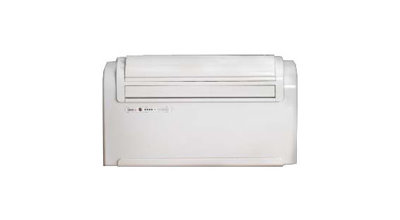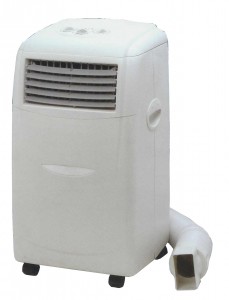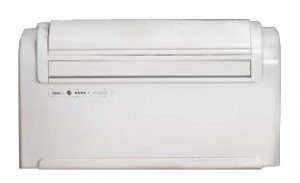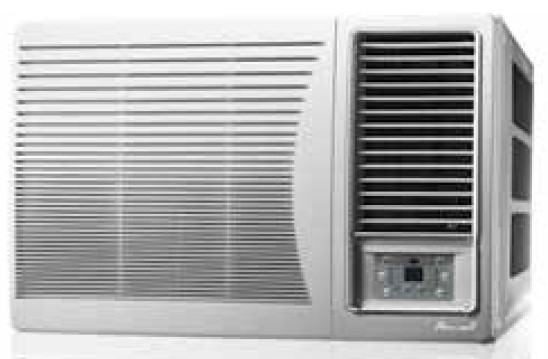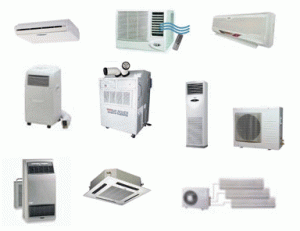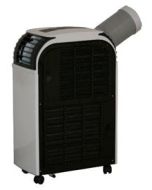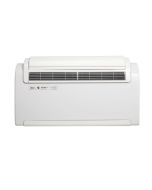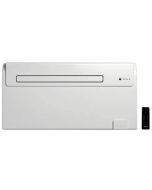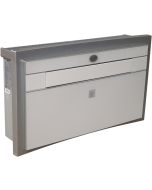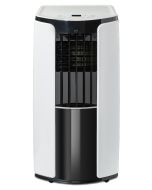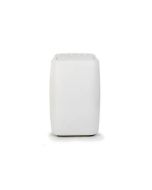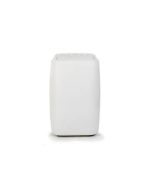Air Conditioners FAQ
Air Conditioners FAQ: How do air conditioners work?
No air conditioners FAQ page would be complete without an answer to the most elementary question. The best description of how they work is as a fridge does but backwards. In the same way that fridges and freezers use heat transfer coils, piped refrigerant and a compressor, air conditioners take heat from inside and transfer it to the outside, and have a fan to ensure that sufficient air (therefore heat transfer) is pushed through the cooling fins.
What are monoblock air conditioners?
These are typically the smallest type of air conditioners and are self-contained, usually portable air conditioning units.
The mobile monoblock air conditioners always have a hose exhaust (similar to a tumble drier), which needs routing through a window (the window will need to be able to open at least 150mm (6") or door. A more permanent installation may have a duct though a wall that the hose can be connected to. They are generally speaking easy to move about from room to room, however the exhaust hose needs setting up each time.
If you have a suspended ceiling it may be possible to route the exhaust hose above the ceiling. Generally they are suited to domestic and small commercial use. Some have the added benefit of heating capability making the unit a year round useful appliance. Larger commercial units are available and known as either spot coolers or industrial mobile air conditioners.
What is a split air conditioner?
All air conditioners need some sort of means of discharging the heat that they are taking from the room being treated. With monoblock air conditioners the heat is pushed outside on air through an exhaust hose, but, with split air conditioners the 'condenser unit' is separate from the main unit and the two elements are connected by a flexible line that carries the refrigerant piping. Given that air conditioning works best when windows and doors are closed, these units are useful because the flexible line can go through a very small window opening to the condenser unit mounted outside, say on a window ledge.
Do they all have a vent pipe?
They all have some means of transferring heat from the inside, however it is the mobile monoblock air conditioners that always have an exhaust hose.
What are the advantages of a wall mounted unit?
When there is not enough floor space to easily accommodate a portable air conditioner, a wall mounted unit can be an ideal solution. There are two different types;
Firstly there are split wall mounted air conditioners (i.e. they have an inside unit and an outside unit joined by an umbilical cord of insulated copper pipes) and as they come in separate parts they do need specialist installation in order to make safe connection of the pipe to the unit and to make the connection to electrical supply. It follows, therefore, that a split wall mounted air conditioner is a permanent installation that adds value to your home, rather than merely a portable appliance. The other great advantage to our split units are that they are also heat pumps, providing exceptional value warmth to the room during the winter months. A split wall mounted air conditioner with a heat pump is fractionally more expensive than one without, however a heat pump cannot be retrofitted to a standard wall mounted air conditioner
Secondly there are wall mounted monoblock air conditioners. These units are becoming more popular because they do not require a refrigeration engineer to fit them (unlike the wall mounted split air conditioners) and also because the old-fashioned window air conditioners (see separate section below) are becoming much rarer as manufacturers discontinue their product to comply with increasingly stringent efficiency regulations. The wall mounted monblock air conditioner tends to look a bit like a storage heater. It is always mounted on the inside of an external wall so that its twin ducts can be fitted within the wall to connect the air conditioner to outside. The great advantage for the wall mounted monoblock air conditioner is that it can in most cases be fitted completely as an inside job - ideal if you live in a block of flats. Also the only external visible sign of an air conditioner is the two small louvered ends of the ducts, which means that they are ideal for fitting into listed buildings and other buildings where there are planning restrictions.
What is a heat pump?
Our larger air conditioners (the wall mounted units and the 41000 BTU/hr floor mounted split unit) have heat pumps. This means that not only do they cool the air in the room during the warm months, they also warm it in the cooler months. It is an incredibly efficient method of providing heat to a room because for every kw of electrical energy you put into the machine it will typically delivers around 2 to 3 kw of heat energy, unlike other heaters where what you put in is roughly what you get out as heat. It is one of those few instances in life where you get more out than you put in! Look for the coefficient of performance (COP) rating on the specification table for the particular model. This is the ratio of electrical energy 'in' to heat energy 'out'. The higher the figure the more efficient the heat pump. For new house building or major refurbishment work, you would be mad not to seriously consider a heat pump as a heating solution.
They work by clever use of refrigerant which alternates between being a liquid and gas, depending on the pressure and temperature that it is at. With a 'reverse cycle' feature they not only absorb and transfer heat from your inside air to outside, they also have the ability to extract heat energy from outside air and transfer it to inside, even when it is cold outside. To understand the concept of a heat pump, don't think so much about inside vs. outside temperature; consider instead that by making what is already cold outside air even colder, that heat energy can be extracted and transferred.
What is a 'through the wall' or 'window' air conditioner?
Through the wall units are designed to be mounted through a wall (or window) so that one end points inside, to supply the cold air and the other end points outside for the heat exhaust and drainage. As the unit is exposed to both inside and outside there are no hoses or pipes to worry about. These units are almost a standard item in houses in warmer countries, particularly in the Mediterranean and Middle Eastern countries. Recently more demanding european efficiency regulations have meant that window air conditioners are no longer compliant and are therefore prohibited from import to the EU. They are now almost impossible to obtain.
How should I compare and choose between different models?
The key element is to know what is how many BTUs are needed to effectively cool the space. Help on how to work it out is in the 'How do I work out what size air conditioner I need?' question. Once you know what BTU rating your air-conditioning needs to then the next stage is to decide how best to satisfy that requirement and for this you need to consider air 'throw'. Most units can 'throw' the cool air to about 4 m so if you have a long room it is better to have a couple of smaller units rather than a single large one. It is generally better to use the higher rating units for rooms where there is an above average or high heat load.
You need to decide what type of unit you need. Generally monoblocks are suited to domestic use and limited commercial applications, split units can also be used in domestic applications, however are more likely to be used in offices and commercial applications. The portable ones are easy to use and don't really need any installation as such. Through the wall units, ceiling and wall mounted units are generally used commercially and in larger, luxurious houses, and require some installation work. They tend to be rather more expensive, particularly, when the installation costs are added in, however add value to the building and often have the advantage of a heat pump facility to provide exceptionally economical heat in winter.
Beyond these basic considerations, the choice is largely based on performance, size, features, aesthetics, and brand.
How do I work out what size air conditioner I need?
It's quite easy; follow this simple method...
a. Measure (in metres ) the room that you want to air condition
b. Work out the volume of the room i.e. length x width x height. For more complex shape rooms you may need to break the room into obvious sections, work out each section volume and then add the volumes together. This will give you a room volume in m3.
c. Look at the table and the heat load explanations below and choose which type of room most closely resembles the one you wish to air condition. Or click the button below to use our calculator
| Room type | Heat load | Large south-facing windows in room? | Factor |
| a | average | no | 175 |
| b | above average | no | 244 |
| c | high | no | 300 |
| d | average | yes | 262 |
| e | above average | yes | 366 |
| f | high | yes | 465 |
| Heat Load explanations | |||
| average | The room is a normal residential room, office, reception area or similar, where there is not overly crowded with people, computer and office equipment. | ||
| above average | There are factors that contribute to additional heat being generated in the room e.g. strong lighting, overcrowding with people and office equipment, conservatory type room, or flat-roofed room. | ||
| high | There are factors that contribute to a high heat load in the room. e.g. commercial cooking, much computer and server equipment, switch gear, temporary building with thin walls and flat room, plain glass conservatory | ||
d. For the type of room that most closely resembles yours, take the corresponding factor and multiply it by the room volume. This gives you a value in BTU (British Thermal Units) You should then look for an air conditioner or combination of air conditioners that has at least this BTU rating.
example
Room size is 4m wide, 5m long and 2.5m height. The room volume is 4 x 5 x 2.5m = 50m3. The room is an office with rather more computers, printers and people than is comfortable, and this contributes to the heat in the room; the only windows are north facing. Room type b is the closest match, for which the factor is 244. Therefore 50 x 244 =12200 BTU. We need an air conditioner that is rated to at least 12200 BTU.
If you need help .. just give us a call!
Note. Be aware of a units ability to 'throw' air. Given that air conditioning units generally don't throw air more than about 4 m, it would be a mistake to put in a single unit into a long room that is, say, over 7m, as the end on the room is unlikely to get the effect of the air conditioning. A more effective solution is to use the appropriate number of smaller units to make up the BTU requirement for the room and locate them well apart.
How do you convert from BTUs to watts and visa versa?
Our air conditioning systems and units are generally rated in British Thermal Units (BTU), but you may have a watts (w) or kilowatts (kw) rating in mind. The following should help;
1 BTU = 0.293 w 1 watt = 3.413 BTU 1 kw = 3413 BTU
What about condensates drainage?
All air conditioners dehumidify the air as well as cooling it. It results from condensation forming on the cooling fins of the unit. On split units the condensate will drip into a catchment tray and then flow through a flexible line to a drain. Thought needs to be given to the drainage of a split unit, i.e. where is the nearest suitable drain point? ; is there enough pipe to reach it? ; do you need pump (if for instance the pipe route involves some lift). Mono blocks do not need particular drainage arrangements as the condensate is evaporated into the exhaust air flow.
Does my air conditioner need a pump?
If you are installing a split unit and the drainage pipe is to be installed with an 'uphill section' this will prevent condensates from flowing to the drain. To ensure that condensates are drained it is recommenced that a peristaltic pump is installed in the pipe upstream of the uphill section. This ensures that the pump is always at the wet end of the pipe and will not be working the pipe when filled with air.
What happens if there is not enough refrigerant in the air conditioner?
This can happen if a precharged unit and condenser is connected with refrigerant lines that are longer than the standard supplied and not topped up with extra refrigerant to fill the additional volume. What would tend to happen is that the condenser will over heat leading eventually to failure.
What happens if my air conditioner is too small for the room?
When units are undersized the effect is that the unit has to work too hard in order to get to and then to maintain the right temperature and the cooling coils get too cold and ice up (i.e. the condensation can freeze rather than drain off). Once iced up the air cooling effectiveness is quickly lost as air flow through the coils becomes restricted. For this reason it is important to ensure that the unit is the correct size for the room. See How do I work out what size air conditioner I need?
What happens if my air conditioner is too large for the room?
When a unit is too large for a room it means that the target temperature in the room is reached very quickly and not only will there be too much cooling effect, but also there will likely be too much airflow, so that the effect on the occupants of the room will be that they will feel a cold drafts, whenever the unit self activates on its thermostat. See How do I work out what size air conditioner I need?
What should I do if the room I want cooled doesn't have a window or suspended ceiling?
Without a window, suspended ceiling or some means of easy access to a 'heat sink' (i.e. air to transfer the heat to) then air conditioning is going to be a bit more expensive, as a means of transmitting heat to outside would have to be installed. You could look at the split units (either the mobile ones or wall mounted) to see if they have a flexible line that is long enough to route to the nearest suitable heat sink (i.e. outside). If the standard flexible line is too short then you could buy a longer length, but would more than likely need and air conditioning engineer to fit it and top up the refrigerant levels. If that route proves to expensive then you should consider evaporative coolers. Working on a simpler mechanism than air conditioner, they are generally much cheaper than air conditioners and don't need the access to outside air.
What effect does air conditioning have on humidity?
When cooling the air, an air conditioning unit will have the inevitable effect of removing moisture from the air. This is because condensation forms on the cooling fins, in the same way it forms on the cold glass of a window. The condensation either drains to a tank or is transferred outside. This means that all air conditioners have some dehumidification capability, and their water removal capacity is usually noted in their specifications. When UK summer so often means warm wet air that feels 'sticky and sweaty', the air conditioned air is by comparison cool and dry. Two problems solved in one!
What should I do if I can't afford an air conditioner?
Consider evaporative coolers.
If you need help on solving a cooling problem or choosing an air conditioner, just ask us - 0845 688 0112

